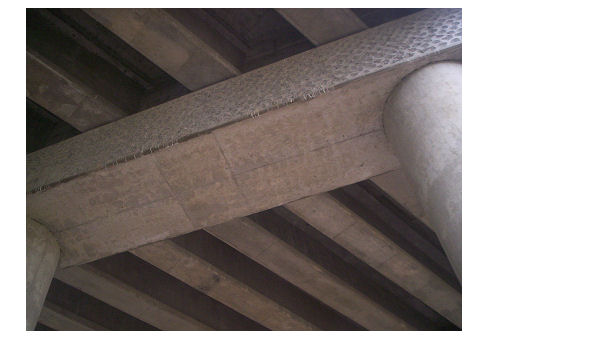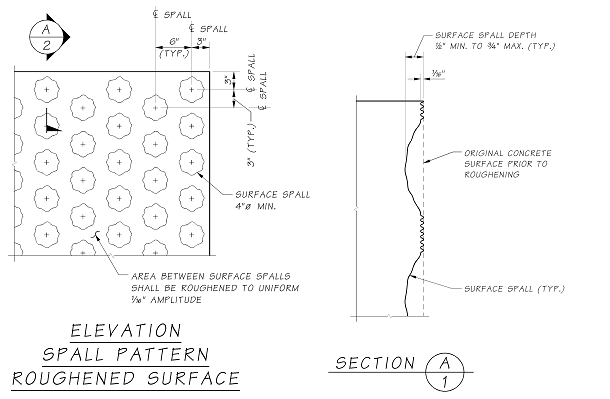
Interface Shear Transfer - Shear Friction Design is to be performed in accordance with AASHTO LRFD Bridge Design Specification Section 5.8.4. The concrete and the interface shear reinforcement are both effective as described in AASHTO. When designing for shear transfer between new and existing concrete, the Designer shall consider the high construction cost associated with roughening existing concrete surfaces. Whenever practical, the design for placing new concrete against existing concrete shall be completed such that roughening of the existing concrete surfaces is not required (i.e. use cohesion and friction factors for a surface that is not intentionally roughened). When the additional capacity provided by a roughened surface is required, the surface roughening shall meet the requirements specified in Section 5.8.4.3 of the AASHTO LRFD Bridge Design Specification (i.e. uniform ¼-inch minimum amplitude). WSDOT Standard Specification Section 6-02.3(12), and applicable WSDOT special provisions for concrete removal, will be updated effective August 3, 2009 to require a uniform ¼-inch amplitude roughening wherever an existing concrete surface is specified to be roughened on the plans. The Amendment to WSDOT Standard Specification Section 6-02.3(12) is attached for reference. Construction of a uniform ¼-inch amplitude roughened surface is difficult and expensive to construct on existing concrete surfaces. Furthermore, consistently measuring and enforcing the uniform ¼-inch roughening has been problematic in the past. As part of recent WSDOT construction projects, an alternative existing concrete surface roughening has been accepted by WSDOT. This alternative Spall Pattern Roughening is shown in the photo and details below. There are several advantages to using the Spall Pattern Roughening, which include: 1) the Spall Pattern is quicker and easier to construct, 2) the Spall Pattern is less expensive to construct, 3) the Spall Pattern is easy to quantify/measure and enforce. The Spall Pattern Roughening may be included on projects as an alternative to the default uniform ¼-inch amplitude roughening. The details shown below must then be included on the Plans.
In recent years, there has been inconsistency between Design Code roughening requirements and the WSDOT construction requirements for roughening existing concrete surfaces, as set forth in the WSDOT Standard Specifications and Special Provisions. In addition, constructing, measuring, and enforcing roughening requirements for existing concrete surfaces has been problematic. In some instances, such as sections 5.2.4.D and 5.5.4.A.5, the BDM directs designers to consider only one of either the concrete surface or the reinforcement as effective for interface shear transfer. The BDM will be revised so that it is clear both should be considered concurrently. If you have any questions regarding these issues, please contact Craig Boone at 705-7172 or Bijan Khaleghi at 705-7181. cc: Mohammad Sheikhizadeh, Bridge Construction - 47354
Alternative Spall Pattern Roughening Details
6-02.3(12)A Construction Joints in New Construction If the Engineer approves, the Contractor may add, delete, or relocate construction joints shown in the Plans. Any request for such changes shall be in writing, accompanied by a drawing that depicts them. The Contractor will bear any added costs that result from such changes. All construction joints shall be formed neatly with grade strips or other approved methods. The Contracting Agency will not accept irregular or wavy pour lines. All joints shall be horizontal, vertical, or perpendicular to the main reinforcement. The Contractor shall not use an edger on any construction joint, and shall remove any lip or edging before making the adjacent pour. If the Plans require a roughened surface on the joint, the Contractor shall strike it off to leave grooves at right angles to the length of the member. The grooves shall be ½-inch to 1-inch wide, ¼-inch to ½-inch deep, and spaced equally at twice the width of the groove. If the first strike-off does not produce the required roughness, the Contractor shall repeat the process before the concrete reaches initial set. The final surface shall be clean and without laitance or loose material. If the Plans do not require a roughened surface, the Contractor shall include shear keys at all construction joints. These keys shall provide a positive, mechanical bond. Shear keys shall be formed depressions and the forms shall not be removed until the concrete has been in place at least 12-hours. Forms shall be slightly beveled to ensure ready removal. Raised shear keys are not allowed. Shear keys for the tops of beams, at tops and bottoms of boxed girder webs, in diaphragms, and in crossbeams shall: Unless the Plans show otherwise, in other locations (not named above), shear keys shall equal approximately ? of the joint area and shall be approximately 1½-inches deep. Before placing fresh concrete against cured concrete, the Contractor shall thoroughly clean and wet the cured surface. All loose particles, dust, dirt, laitance, oil, or film of any sort shall be removed by method(s) as approved by the Engineer. The cleaned surface shall be saturated with water for a minimum of 4 hours before the fresh concrete is placed. Before placing the reinforcing mat for footings on seals, the Contractor shall: 6-02.3(12)B Construction Joints Between Existing and New Construction If the Plans or Special Provisions require a roughened surface on the joint, the Contractor shall thoroughly roughen the existing surface to a uniformly distributed ¼-inch minimum amplitude surface profile, with peaks spaced at a maximum of 1-inch, by method(s) approved by the Engineer. If the Plans or Special Provisions do not require a roughened surface on the joint, the Contractor shall thoroughly remove all loose particles, dust, dirt, laitance, oil, or film of any sort by method(s) approved by the Engineer. Before placing fresh concrete against existing concrete, the Contractor shall thoroughly clean and saturate the existing surface. All loose particles, dust, dirt, laitance, oil, or film of any sort shall be removed by method(s) as approved by the Engineer. The cleaned surface shall be saturated with water for a minimum of 4 hours before the fresh concrete is placed.
|

